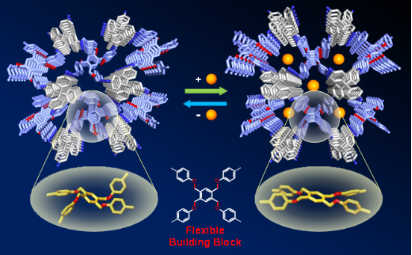Prestigious journal publishes research on advances in flexible three-dimensional covalent organic frameworks
The Journal of the American Chemical Society recently published the latest findings of Prof. Wang Cheng's team from the College of Chemistry and Molecular Sciences, Wuhan University, which reveals three-dimensional covalent organic frameworks (COFs) can be constructed from flexible building blocks.
This paper is entitled A Crystalline Three-dimensional Covalent Organic Framework with Flexible Building Blocks. PhD student Liu Xiaoling (enrolled in 2018) and Dr. Li Jian (Peking University) are the co-first authors. Prof. Cheng Wang and Sun Junliang (Peking University) are the co-corresponding authors.
Covalent organic frameworks (COFs) represent an emerging class of crystalline porous materials with designable functionality and promising applications. Currently, COFs-related research focuses mainly on 2D COFs with 3D COFs receiving less coverage. This can be explained by their synthetic driving force being derived mainly from the formation of covalent bonds, which poses a considerable challenge to efforts in precision control of the bonding process of 3D frameworks at the atomic level. Currently reported systems are constructed from rigid precursors. In principle, it should be possible to also construct 3D COFs from flexible building blocks, which may endow the resulting 3D COFs with flexible properties. However, the synthesis is rather challenging, not to mention problems of structural defects and conformational diversity that the introduction of flexible building blocks presents, thus making structural characterization difficult. Such being the case, relevant research has not been reported.
Prof. Wang Cheng and his team designed a flexible precursor with C-O single bonds in the backbone. Using the “4+4” connection scheme previously proposed by his research group (J. Am. Chem. Soc. 2016, 138, 3302; J. Am. Chem. Soc. 2017, 139, 8705; Acc. Chem. Res. 2020, 53, 2225), Prof. Wang Cheng’s team successfully synthesized the first highly crystalline flexible 3D COF (FCOF-5) containing flexible building blocks. Then, by using the advanced continuous rotation electron diffraction (cRED) technique and an approach similar to protein structure analysis, the team successfully determined the crystal structure of FCOF-5 by merging 17 cRED data sets. Interestingly, FCOF-5 can undergo reversible expansion/contraction upon solvent vapor adsorption/desorption, indicating a breathing motion. This research fully demonstrates that 3D COFs can be constructed from flexible building blocks, the introduction of which can endow 3D COFs with special dynamic properties. The resulting 3D COFs represent a new type of flexible crystalline porous materials.

Link to the paper: https://pubs.acs.org/doi/full/10.1021/jacs.0c12505
Rewritten by Wu Xingwen
Edited by Wu Buer